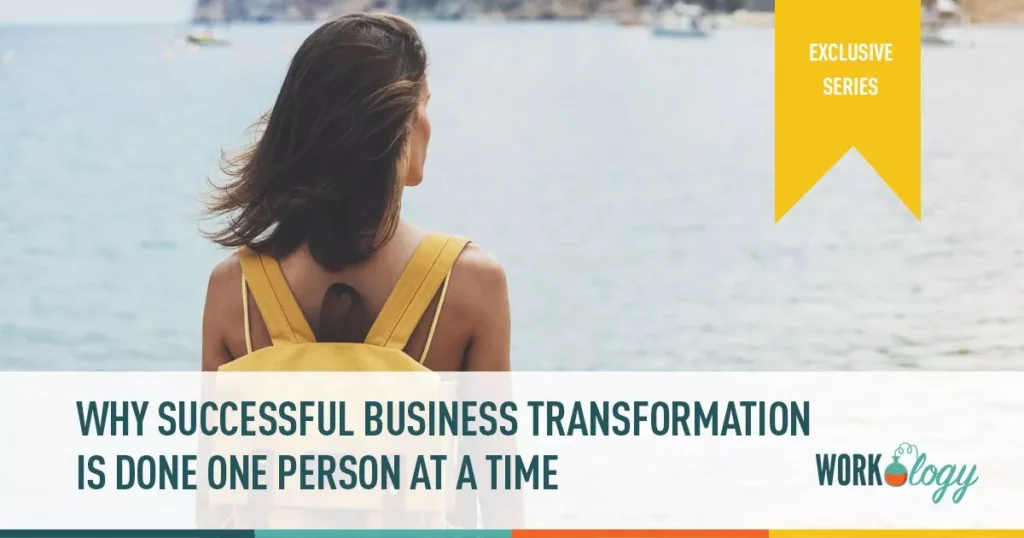Why Successful Business Transformation is Done One Person at a Time
Hanlon’s Paradox states that the stress caused by change reduces our ability to cope with change. At the very moment, we need to be open to new ideas and learn new ways of doing things, the expectation of having to change surfaces fears and doubts that lowers our self-esteem and prevents us from adapting.
Most businesses are either unaware of or forget about Hanlon’s Paradox when undergoing a major organizational transformation effort — and this is why three quarters of transformation initiatives are unsuccessful. The most well-thought through strategies fail because changing a business means helping each person make the needed changes, one individual at a time.
For large global organizations, this can seem like an impossible task, so too many fall back on carefully scripted town-hall presentations and/or mass emails to communicate the change and hope for the best. Unfortunately, no matter how good this content is, everyone is still left feeling the same stress and asking the same question: “what does this mean for me?”
A Personalized Approach to Change
In my experience leading companies through successful transformations, the key to this success was focusing on ensuring that every single person in the organization understood why a change is necessary and how it impacts the definition of their role and how they perform their work.
Because most people are inherently resistant to change, it takes time for them to gain the necessary confidence and courage to look further ahead and move outside their comfort zone. Leaders need to have empathy for their people in the face of transformational or even everyday change, and commit to helping each one build resiliency and make the needed changes.
Instead than assuming that communications will be delivered effectively down the hierarchy, senior executives must interact personally with all levels of the business. CEOs should prepare to participate in small group talks, especially with the best performers at every level, even though it is not acceptable to expect them to meet one-on-one with every employee. People will relate to the shift better and be better able to adjust if everyone has the opportunity to ask questions and express concerns in a more intimate, personalized setting.
Drive Change With These Three Questions
One simple structure for coaching and performance development in times of transformation is the Stop/Start/Continue conversation. It comprises three simple questions that both the manager and team member answer:
- What activities/behaviors should I Stop doing?
- What activities/behaviors should I Start doing?
- What activities/behaviors should I Continue doing?
It is especially important for senior leaders to have regular Stop/Start/Continue conversations with the people managers who report to them. Every manager plays an outsized role in influencing the needed change, and if they remain too focused on deliverables and not on their people it creates a disconnect.
Used honestly and regularly, Stop/Start/Continue is a powerful tool for both large transformations and day to day development. We use it at my current organization, Vertiv, as part of a continuous performance process for all of our 18,000 employees based in 25 locations worldwide. We use Betterworks’ technology to transparently set and align our quarterly OKRs (Objectives and Key Results) and to capture the “Stop/Start/Continue” conversations at each quarter-end. Technology is useful because it provides needed transparency to keep everyone aligned and it prompts managers to have these regular discussions.
Making Change Everyday
Because the only constant is change, leaders and managers can also use Stop/Start/Continue questions for the continuous, forward-focused employee development conversations that need to be part of the everyday flow of work.
Although managers may have weekly one-on-one meetings with every direct report, these discussions are frequently quite tactical and concentrated on the specific tasks in motion. Or, firms rely solely on infrequent, ineffective performance assessments that don’t emphasize acquiring the skills necessary for ongoing success. The more commonplace type of transition necessitates regular discussions about long-term objectives, skill development, and career advancement – dialogues that will ignite change and keep people, teams, and the entire company moving forward.










One Comment
agree with the thoughts shared in this blog . I would like to share my article
Today, work-life balance is an evolving concept but, put simply, it’s about achieving the mix of business and personal life that’s right for you. Learning to strike a balance between work and life is an ongoing art.
Comments are closed.